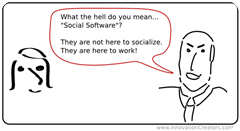Enterprise 2.0
So what is it? Why do you need to keep reading this? Well you probably don’t, unless you work in an organisation with internet access and more than one person there. Well that’s most if us!
Did that get your attention?
How about this?
Has Facebook, MySpace, YouTube or Google videos been banned in your workplace? What about instant messaging or Skype?
I want to talk a little about why this has happened, and for the wrong reasons, and also how it will change in the very near future.
 Organisations have been very jealous of their employees time (and they have a legitimate right to require their workers to be focussed on work not their social lives while in their employ. IT managers and CIO’s have seen applications like Facebook and messenger to be purely time wasting social applications with no business use. That is starting to change.
Organisations have been very jealous of their employees time (and they have a legitimate right to require their workers to be focussed on work not their social lives while in their employ. IT managers and CIO’s have seen applications like Facebook and messenger to be purely time wasting social applications with no business use. That is starting to change.
Lets start with what Web 2.0 is and work our way up to Enterprise 2.0.
The concept of Web 2.0 is very simple. According to Wikipedia, Web 2.0 is a term that “encapsulates the idea of the proliferation of interconnectivity and interactivity of web-delivered content.” What the! Ok a more normal explanation is web content that is not just informative (Web 1.0), but interactive.
So sites like Facebook are Web 2.0, because there is a multi-user, multi-application , multi-media interface that allows interaction between participants and can leverage that to create great interconnected content.
So how does knowing that change my world while I am at work, especially when Facebook is banned?
Good question. The answer lies in the knowledge inside your head. As a worker, you have information and knowledge, access to material and data that makes you useful. To the organisation as a whole, and also laterally to other workers with the same job or requirements for information as you. The concept of benchmarking is not new, but in a corporate sense usually applies to think tank brainiacs or the corporation as a whole, and is generally seen as an overseas junket for the few privileged to go on!
The internet changes everything. As businesses start to become more connected, their workers in particular also get more connected. Email address lists start to grow. Many knowledge workers spend many hours per day using email. 23% of my time on the computer is in Outlook. I have tracking software in place that tells me that. Much of this information that is being emailed is one dimensional, badly sorted and indexed and often duplicated many times. The wasted effort is huge. As organisations start to realise the untapped resource of workers email folders they will start looking for ways to leverage it.
![clip_image001[7] clip_image001[7]](http://www.spyjournal.biz/files/clip_image0017_thumb.png) Dion Hinchcliffe talks about Finding Web 2.0 and says this:
Dion Hinchcliffe talks about Finding Web 2.0 and says this:
“Sometimes dubbed "Web 2.0", this new, more refined model for creating online software reflected an improved understanding in the way that large networks can provide their full value. Specifically it reflected how to make use of them when a lot of users can actively contribute to them, directly or indirectly. This left the linear concept of Web traffic behind forever…”
Enter Enterprise 2.0. The entry point for most organisations is with email simply because it is such a huge and easy target. Applications like Xobni give power back to the individual but still don’t help the corporation. Sharepoint is a major step forward because it can not only allow email to be managed in a database it also has the ability to turn the one dimensional network folders containing users files into multidimensional relational databases. Search functions now actually work and suddenly the version control features start to reduce the wasted time with emailing files around. Wikis and conversations about files and projects can be tracked and managed better. As enterprises start to value data for its intrinsic value and not just for its sheer volume the path to Enterprise 2.0 awakening starts to shimmer more brightly.
![clip_image001[5] clip_image001[5]](http://www.spyjournal.biz/files/clip_image0015_thumb.png) Some pictures can help here. Rod Boothby’s Enterprise 2.0 Communication Continuum was modified by Dion Hinchcliffe in his article about Enterprise 2.0. The concept of leveragability of the “conversations” that are held by staff in an organisation is the whole key to Enterprise 2.0. Without a perceived benefit to an organisation there is no need to use blogs, wikis, instant messaging, search tools or even email. It is the ability for an organisation to increase productivity, retain knowledge and leverage the untapped resources that will force businesses to adopt Enterprise 2.0 in some format.
Some pictures can help here. Rod Boothby’s Enterprise 2.0 Communication Continuum was modified by Dion Hinchcliffe in his article about Enterprise 2.0. The concept of leveragability of the “conversations” that are held by staff in an organisation is the whole key to Enterprise 2.0. Without a perceived benefit to an organisation there is no need to use blogs, wikis, instant messaging, search tools or even email. It is the ability for an organisation to increase productivity, retain knowledge and leverage the untapped resources that will force businesses to adopt Enterprise 2.0 in some format.
Here are some excerpts from an internal research document a local government agency produced recently about the requirement to better manage their internal knowledge:
- The existing network storage system is clumsy and does not provide metadata about files
- We need to identify and foster subject matter experts, and knowledge champions
- We need to define a taxonomy by which to tag information and files with metadata
- We need to foster a knowledge sharing culture
- IS systems need to be aligned with and measured against the KM requirements of the business
- Additional KPI type measurements such as response time to customer requests need to be captured
- Employee learning must be actively encouraged and shown to be contributing to the organisation
These “pain points” are all great starters to help an organisation to start to see the value of Enterprise 2.0 As they stat to look for ways to address these issues, all the signs point to software that is web 2.0 based or similar. Applications like SharePoint, Instant messaging, Twitter, and the sundry services that surround them.
I have helped several organisations down this path toward Enterprise 2.0
- Accepting the value of the data in their business and looking for ways to leverage it
- Accepting the usefulness of workers viral networks – both internal and external to the organisation and facilitating use of those networks.
- Recognising that social networks can contain invitations and introductions to other people or businesses that can add value to the corporate. Hiding them from workers is counter productive.
- Teaching employees to trust the organisation and allow mutual trust to develop – some form of privacy of personal data and connections while allowing interactions that can gain a benefit to the organisation.
The ongoing challenge for Australian businesses, and indeed business the world over, is to identify for themselves the place that “social software” has in their business as a tool for leveraging the powerful hidden data that resides in networks, non indexed email and IM messages, and to build and foster an environment that encourages their staff to value, add-to and share corporate knowledge.





Comments
and thanks to Kate for the
and thanks to Kate for the inspiration to write this
http://carruthk.blogspot.com/2008/10/what-is-all-this-social-stuff-about...
... that is interesting stuff
... that is interesting stuff you've written, need to thinks some more about it. I think we're about to ferment the next stage of Enterprise systems :)